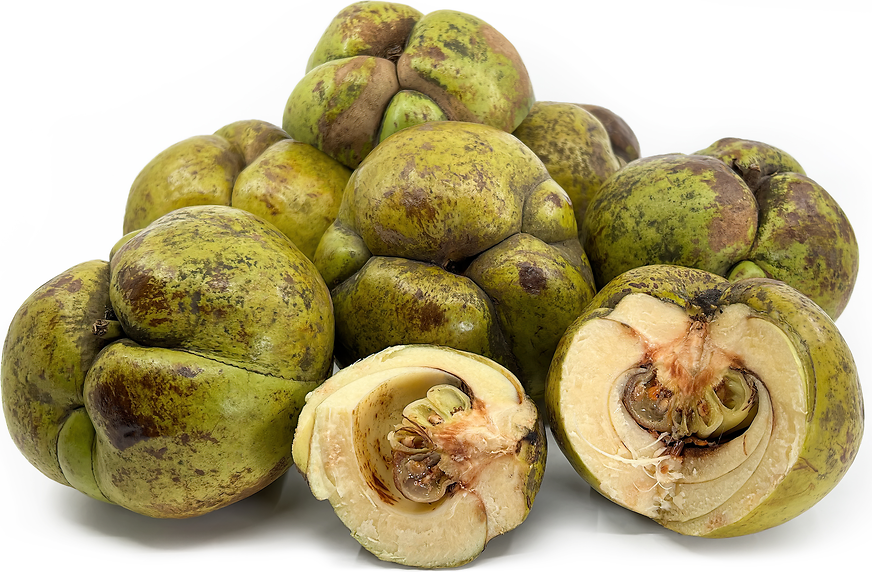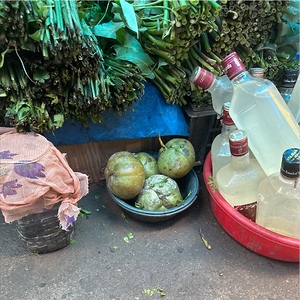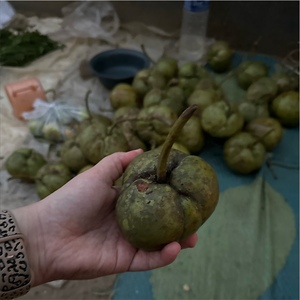


Elephant Apples
Estimated Inventory, lb : 0
Description/Taste
Elephant apples are a large fruit, averaging 5 to 12 centimeters in diameter, and have an irregular shape comprised of multiple round, lumpy, and swollen fused sections. The fruit's exterior is waxy, leathery, taut, and firm, ripening from green to yellow-green and sometimes speckled with dark brown markings. Underneath the tough husk-like surface, layers of fleshy sepals have overlapped and fused together. The ivory to cream-colored sepals are fibrous, chewy, crunchy, and stringy and are customarily cooked to soften their dense texture. Inside the overlapping sepals, there is a pocket of aggregate pulp that is soft, mushy, and fleshy. The pulp is known for its crisp, but mucilaginous, gelatinous, sticky, viscous nature and generally showcases a dark brown-green hue. The flesh also encases anywhere from 1 to 8 small, flat, brown seeds often lined with hairs extending outward. Elephant apples should feel heavy for their size, and the fleshy pulp in the center of the fruit will gently rattle or move inside when it is ripe. The fruit's sepals, also called petals, have a bitter, sour, vegetal, tangy, and acidic taste reminiscent of green apples or grapes. The petals are known for carrying a distinct garlicky funk that may be off-putting to some consumers. The sticky flesh has a sour, astringent, and somewhat resinous nature, mostly sprinkled with sugar in dishes to create a more balanced, sweet, and salty flavor profile.
Seasons/Availability
Elephant apples are available in the fall through early spring.
Current Facts
Elephant apples, botanically classified as Dillenia indica, are a rare species belonging to the Dilleniaceae family. The fruits are native to Asia and grow on evergreen trees reaching up to 15 meters in height. Elephant apples are not commercially produced and are typically foraged from wild trees or trees planted in home garden landscapes. The fruits are also known as Chalta, Ouu, Owtenga, and Chulta in India, Simpoh in Malaysia, Simpur Air in Indonesia, and San-Pao and Matat in Thailand. Elephant apples received their pachyderm moniker from the fruits being a primary food source for Asian elephants. Experts believe elephants and other animals consuming the fruits is the main explanation behind the plant's regional expansion throughout history, and the fruit's seeds are expelled in excrement, allowing the seeds to take root wherever the animals travel. In the modern day, Elephant apples have become a favored foraged ingredient among communities in Asia, and these regions are struggling to find a balance between leaving the fruits for the animals and allowing humans to forage the fruits for cooked preparations. Elephant apples are popularly used in cooked, aromatic, spice-filled side dishes.
Nutritional Value
Elephant apples are a source of fiber to regulate the digestive tract, vitamin C to strengthen the immune system while boosting collagen production, and calcium to build strong bones and teeth. The fruits also provide phosphorus to repair tissue, potassium to balance fluid levels within the body, vitamin A to maintain healthy organ functioning, and other nutrients, including B vitamins, riboflavin, vitamin E, beta-carotene, and thiamine. In India, Elephant apple juice is used as a hair and scalp mask to soften strands and remove dandruff. The fruits are also used in natural medicines as a detoxifying agent, anti-inflammatory, and cough soother.
Applications
Elephant apples have a sour, bitter, and subtly acidic flavor typically served in cooked preparations. The pulpy center of the fruit can be blended into drinks, tossed with sugar and eaten raw, or mixed with honey and served as a breakfast dish. The pulp can also be simmered into jams and jellies or blended with coconut milk and sugar to make shakes and ice cream. In addition to the pulp, the fibrous, crunchy, and fleshy interior surrounding the sticky pulp is also consumed, popularly added to curries, chutney, and other Indian dishes. Elephant apples are sliced, boiled in a sugar and water mixture, and then strained and pressed to release any remaining bitter juices. Once boiled, the pieces are sauteed in various mixtures of spices, aromatics, and sauces to create aromatic dishes. In India, Elephant apples are cooked into dal and served with fried fish, added to chutney and served with rice and coconut, or pickled in spices as a crunchy condiment. Beyond the fruits, the young leaves are sometimes eaten in salads in Thailand. Elephant apples pair well with spices such as turmeric, coriander, cumin, fennel, and masala, aromatics such as garlic, onion, and chile peppers, mustard oil, brown sugar, lentils, and fruits including papaya, mango, and cempedak. Whole, unopened Elephant apples will keep up to one month when stored in the refrigerator or a cool and dark place.
Ethnic/Cultural Info
In the northeastern state of Assam in India, Elephant apples are traditionally used to ward off evil in Kati Bihu, an annual fall festival. Kati Bihu represents a time of reflection, penance, and thanks and is celebrated on the first day of the Assamese month of Kati, generally falling on a day in October. The festival also occurs between seasons when rice paddies in the field, the primary food source, have not matured and reserves of grains are low. Kati Bihu is centered around the time between abundance and scarcity, and during the festival, households give thanks to Lakshmi, the goddess of wealth, prosperity, and fortune, and welcome her blessings into the home. Elephant apples are also hollowed, filled with oil, and used as a lamp. Elephant apple lamps are placed in rice paddy fields and are lit as a method of protection over the developing crop. The ignited apples are believed to ward off the evil eye, and the flame acts as a natural insecticide to attract insects in the field. Elephant apple lamps are also placed on bamboo sticks and are used to line walkways into homes to welcome the spirits of ancestors.
Geography/History
Elephant apples are native to Asia and have been growing wild since ancient times throughout regions of India, Thailand, Sri Lanka, Vietnam, Bangladesh, Malaysia, Indonesia, and China. The fruits grow on trees that thrive in tropical to subtropical, humid forests, and the species is also found near swamps, regions with fertile soil, and woodlands. Elephant apples have a concentrated population in India and are found in northern regions, specifically Kolkata and Assam. The fruits are also found in Andhra Pradesh, Madhya Pradesh, Odisha, and Karnataka. Historically, Elephant apples have remained a mostly wild fruit and are not grown commercially. In some regions of Southeast Asia, foraging and selling the fruits is illegal as it is protected to feed the local wildlife. The species was first described by Swedish botanist Carl Linnaeus in his 10th edition of Systema Naturae in 1759. Today Elephant apples are foraged from approved areas of Southeast Asia and are also grown in home gardens as a landscape plant. The species has also been introduced to select botanical gardens in Australia, and seeds for the species are sold through online retailers.









